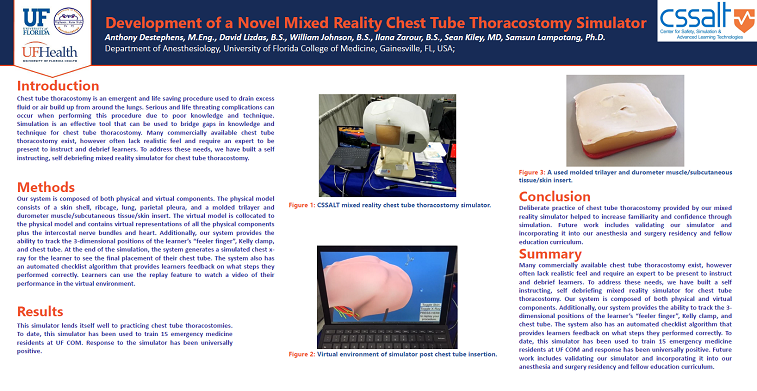2021 FSA Posters
P021: DEVELOPMENT OF A NOVEL MIXED REALITY CHEST TUBE THORACOSTOMY SIMULATOR
Anthony DeStephens, MSME; David Lizdas, BS; William Johnson, BS; Ilana Zarour, BS; Sean Kiley; Samsun Lampotang, PhD; University of Florida
Introduction: Chest tube thoracostomy is an emergent and life saving procedure used to drain excess fluid or air build up from around the lungs. Serious and life threating complications can occur when performing this procedure due to poor knowledge and technique. Simulation is an effective tool that can be used to bridge gaps in knowledge and technique for chest tube thoracostomy. Many commercially available chest tube thoracostomy exist, however often lack realistic feel and require an expert to be present to instruct and debrief learners. To address these needs, we have built a self instructing, self debriefing mixed reality simulator for chest tube thoracostomy.
Methods: Our system is composed of both physical and virtual components. The physical model consists of a skin shell, ribcage, lung, parietal pleura, and a molded trilayer and durometer muscle/subcutaneous tissue/skin insert. The virtual model is collocated to the physical model and contains virtual representations of all the physical components plus the intercostal nerve bundles and heart. Additionally, our system provides the ability to track the 3-dimensional positions of the learner’s “feeler finger”, Kelly clamp, and chest tube. At the end of the simulation, the system generates a simulated chest x-ray for the learner to see the final placement of their chest tube. The system also has an automated checklist algorithm that provides learners feedback on what steps they performed correctly. Learners can use the replay feature to watch a video of their performance in the virtual environment.
Results: This simulator lends itself well to practicing chest tube thoracostomies. To date, this simulator has been used to train 15 emergency medicine residents at UF COM. Response to the simulator has been universally positive.
Discussion: Deliberate practice of chest tube thoracostomy provided by our mixed reality simulator helped to increase familiarity and confidence through simulation. Future work includes validating our simulator and incorporating it into our anesthesia and surgery residency and fellow education curriculum.

